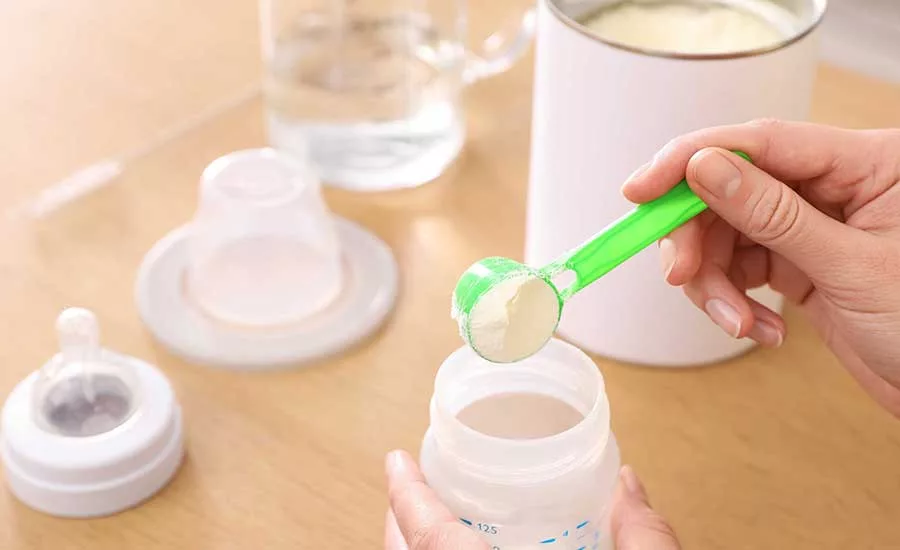How to Improve Salmonella Controls to Create an Effective Cronobacter Control Strategy
Salmonella control strategies are foundational to maintaining safe food manufacturing environments, but those programs must be taken to the next level to ensure that powders are free from Cronobacter

Image credit: Liudmila Chernetska/iStock/Getty Images Plus via Getty Images
As a group of industry food safety volunteers, the Innovation Center for U.S. Dairy's Food Safety Committee has had many dialogues about Cronobacter controls and how to improve programs. As can be imagined, every company's approach and programs are impacted by their situation, plant design, customers, and many other factors. To help share some of the learnings industry has assimilated for Cronobacter control, this article follows the journey of a theoretical example—a typical ready-to-eat (RTE) dry powder plant that is on a mission to reduce and, ultimately, eliminate the incidence of Cronobacter in its environment.
This hypothetical plant had an opportunity to service a new customer, and in the process, it accepted a Cronobacter specification. The plant has a long history of Salmonella control, so plant personnel assumed they would have no issues supporting a Cronobacter testing requirement. For Salmonella, the plant has a strong pathogen environmental monitoring (PEM) program that requires mapping of identified sites, establishing links between selected sites and the potential risk to product they represent, and verification that executed control strategies are effective.
The Salmonella control strategy and PEM program were working, as shown by the plant's success in rapidly identifying and correcting environmental positives. The plant has had sporadic hits in past years linked to specific events—roof leaks, emergency maintenance performed in the packaging room, construction projects, and a few hits in common hallways linked to violations of traffic pattern control. These events were readily identified with the well-established routine PEM program, root causes were reached using a mature corrective and preventive actions (CAPA) process, product risk assessments were conducted, and CAPA were implemented to prevent reoccurrences.
Based on the maturity of the PEM program—which clearly shows strong process controls and food safety culture designed to uphold the critical actions defined in the Pathogen Equation (Figure 1)—plant personnel felt confident that the risk for Cronobacter was also well controlled. So why, when they began finished product testing for Cronobacter, did more than 5 percent of the plant's samples return positive results?

The first action that plant personnel took was to apply their Salmonella PEM program knowledge. They utilized the same sites as their Salmonella PEM program for Cronobacter control verification and found 25 percent of the Salmonella control sites to be positive for Cronobacter. However, a review of the positive sites and vectors taken during the investigation did not show a pattern to link the positives to any specific event, and the more the team sampled to identify a source, the more hits they found. Additionally, their installed Enterobacteriaceae (EB) program, with a detection limit of <100 in the dryer tower rooms and <10 in the packaging room, did not show any trends or unexplained positives. The plant team implemented controlled wet cleaning on the positive sites, with little overall impact on the scope or frequency of the positives.
After this initial data collection and application of previously successful Salmonella control strategies that proved ineffective for Cronobacter, the team realized that the risk profile and behaviors of the two organisms was not the same, and a new strategy was needed specific to Cronobacter.
Plant personnel wanted to implement a new Cronobacter plan, but they had to make sure the plan was based on the latest research and the Pathogen Equation shown in Figure 1. They conducted research and found the FDA's recently gathered information from the infant formula industry and the agency's Cronobacter swabbing assignment conducted in 2014.1,2
Looking for quick answers on food safety topics?
Try Ask FSM, our new smart AI search tool.
Ask FSM →
The team had based their Salmonella control programs on the Pathogen Equation, which they knew worked well. They revisited the equation to ensure they had a strong foundation for building the plant's Cronobacter prevention and environmental monitoring program. After reviewing the FDA findings, the team realized a risk-based approach needed to be taken. They also realized that without reassessing their food safety culture, their plan would not be successful.
By refocusing on the Pathogen Equation in the context of new understanding of the risk, plant personnel realized they were struggling with foundational concepts of food safety culture. Along with many from the dairy industry, the site had participated in a Food Safety Culture Survey.3,4 The survey indicated that our example plant, similar to many other companies, struggles with data management, change management, problem-solving, and recognition. Part of the reason the plant was struggling with problem-solving and change management in this situation was that the team did not have usable data for this specific Cronobacter challenge. This realization focused the team to find root causes and preventive actions, supported and verified by data collected from a revised PEM program. They identified areas with opportunities for improvement and devised a plan focusing on food safety culture; #3, #5, and #6 of the Pathogen Equation; and FDA's findings.
The team's plan included:
- Data-gathering needed to assess controlled conditions.
- Personnel knew that controlled conditions were essential to Cronobacter control, but they were not clear on how often the environment or system was breached. They decided to gather data to identify and quantify their vulnerabilities and to allow for the success of their program implementation to be measured and communicated.
- They initiated projects to: 1) define and quantify breaches of the production equipment and hygiene of process rooms, 2) evaluate and study the air flows within and between production areas to focus on positive pressure and make up air quality, 3) ensure proper sealing of building integrity, and 4) improve HVAC performance and maintenance, including filter classification and change schedule.
- More effective sanitation procedures needed to be developed.
- The current cleaning process was not working. New cleaning procedures needed to be investigated and implemented. Cleaning methods (wet vs. dry), chemicals, and escalation protocols needed to be established.
- The team initiated projects to: 1) evaluate the efficacy of dry sanitizers placed strategically in high-traffic areas, 2) review and redefine existing clean-in-place (CIP) and environmental cleaning protocols with the support of the plant's sanitation chemical provider, 3) assess and revise the efficacy of existing dry-out parameters following any wet cleaning, and 4) define a pre-operational inspection process with "go/no go" acceptance criteria of returning the production environment to operation after cleaning and sanitation activities were performed.
- The environmental monitoring program needed to be adapted and updated to include Cronobacter.
- The plant had been conducting EB monitoring in place of Cronobacter testing, but this was not helping the team find the source of the issues. They also needed to make sure they were conducting the correct type of test at the appropriate sensitivity to get results.
- The in-house laboratory was proficient at indicator testing, using traditional and simple methods of sample dilution and plating; however, it needed data to indicate a sample, or surface area was negative. The lab needed to identify how to convert its "<10" detection limit to a positive/negative result, using a technique that was cost-effective and simple enough to conduct in-house.
- Root cause analysis (RCA) needed to solve the problem, not the symptoms.
- Application of RCA techniques, built on robust data, allowed for a practical and structured approach to solving problems. The team's investigation identified solid Good Manufacturing Practices (GMPs) and process controls, built on sanitary design principles. However, the high incidence of Cronobacter positives in the plant environment indicates likely process control risks/root causes related to hygiene breaches, sanitation practices, and GMP behaviors that needed further understanding to identify improvements.
Salmonella control provides a good foundation, but data for Cronobacter control requires a shift in approach. EB monitoring can provide valuable information about controlled conditions within the production facility, including the control of water, traffic patterns, and GMP behaviors that indicate the defined hygiene zones are being protected and controlled. However, setting action limits of EB at <10 in high-hygiene areas and higher limits (such as <100) in enclosed product processing areas may have provided a false sense of security as to how well the environment was controlled. The plant assessed behaviors in the dryer room and identified:
- Some uncontrolled use of water for situational cleaning
- Improper dry-out after dryer chamber washes
- System breaches
- A lack of sanitation controls for traffic movement within the rooms.
After corrective and preventive actions (CAPA) were taken, plant teams were re-trained on proper control strategies, which were then verified by implementing an EB positive/negative monitoring program.
In our scenario, finished goods are sold to infant formula processors, with the final consumption by a higher-risk group—infants. Since the product goes to a customer with consumers that are higher-risk, the risk determination requires a more robust approach to data evaluation. The link between finished product testing and the data from the PEM program needed to be considered to fully verify controlled processing and finished product food safety. To ensure that this was taken into account, the plant created a batch "positive release protocol" that required review of the Cronobacter PEM and EB positive/negative monitoring of the environment, in addition to enhanced finished product testing to include positive/negative EB, as well as Cronobacter at a higher frequency.
The plant had learned the value of engaging operations, maintenance, and quality assurance in the RCA and program development process, so it leveraged the team's approach to the positive release program. The batch record review included operations verification of process controls against center-lined target values, maintenance risk assessment of activities within the production environment during batch production, and quality assurance review of generated data within the new scope of batch process control. The more robust data set and integrated process control reviews allowed for product risk evaluation and positive release, as well as redefined strategies for lot breaks, based on data.
As the plant journeyed toward improved Cronobacter controls, it identified some key differences between Salmonella and Cronobacter control strategies that helped focus the PEM program (Table 1).
After the corrective actions were defined and executed, the site redeployed its new Cronobacter PEM program. Swab sites were redefined based on the findings of the EB program, and positive Cronobacter findings in the plant environment were reduced. Each new positive site could be linked to behaviors and practices. The plant continued the cycle of root cause investigations for positive sites, using the data to further improve and correct process controls. Even though the site was seeing a reduction in environmental positives, the team was still finding low-level product positives and never found root causes outside of general GMP behaviors and breaches within the processing areas.
As they built their new program, the plant team was finding that data from the revised PEM program was still not sufficient to understand the plant ecology. They also discovered that although they could now see the connection between the plant environment and Cronobacter control, they were still struggling with a specific link between the environment and finished product. Not all Cronobacter positives could be tracked to a specific source to find a root cause and preventive action.
More usable data was needed to find a true root cause, leading to the hypothesis that the team needed to know the exact Cronobacter species to make more direct linkages. They decided to conduct research into technology that would allow for species identification and ecology mapping within the plant environment, so that any product positives could be linked to a plant activity. Once a link could be established, they would be able to execute CAPA to identify and resolve the true root cause, rather than addressing only the symptoms.
After consulting with their contract microbiology laboratory, the plant team learned that technologies were available to identify the specific organisms in both the environment and product, which would allow for stronger data links to root causes of product positives. Those technologies include partial or full genetic sequencing of the Cronobacter positives in the environment and product to uniquely identify which activities in the environment are creating contamination of the finished product. Whole genome sequencing (WGS), 16S RNA, ribotyping, and multilocus sequence typing (MSLT) are some available technologies they compared.
After deploying the enhanced PEM program with new technology, the team determined the full microbial ecology of the production environment, and patterns of microbial niches became evident on the PEM site map. When the next product positive was detected, the genetic identity of that organism was cross-referenced to the site ecology, allowing for the true root cause of the product contamination to be found. This improved data allowed for an ongoing cycle of continuous improvement, based on RCA findings, to evolve and start showing a reduction in product positives. Also, since clear root causes were identified, the plant was able to better define its process for product containment and lot breaks when product positives were found. The program was supported by a data-driven approach to process control where the PEM program and finished product testing data could be directly linked, demonstrating the plant's ability to define and defend a well-controlled system.
The dry industry knows that preventing Cronobacter and Salmonella in low-moisture, RTE foods requires environmental and process controls. However, because the landscape is constantly evolving, manufacturers in high-risk categories may struggle to adequately assess the risks, much less continuously improve their control and mitigation strategies to prevent them. Salmonella control strategies are foundational to maintaining safe food manufacturing environments, but those programs must be taken to the next level to ensure that powders are free from Cronobacter.
While some similarities exist between these control programs, we are learning that the prevention and control strategies for Cronobacter in the plant environment need to be more multi-faceted. Plants with established, mature Salmonella control programs may experience frustration when those established and effective strategies prove insufficient to control Cronobacter, particularly when they are working through CAPA or RCA of a Cronobacter finding. Following the discipline and foundations of the Pathogen Equation and the fundamentals of food safety culture will help create a data-driven program with clear actions to define, prevent, and control Cronobacter risks.
References
- U.S. Food and Drug Administration (FDA). "FDA Issues Warning Letters to Three Infant Formula Manufacturers." August 31, 2023. https://www.fda.gov/news-events/press-announcements/fda-issues-warning-letters-three-infant-formula-manufacturers.
- FDA. "FDA Calls for Enhanced Safety Measures in Letter to Powdered Infant Formula Industry." March 8, 2023. https://www.fda.gov/food/cfsan-constituent-updates/fda-calls-enhanced-safety-measures-letter-powdered-infant-formula-industry.
- Cultivate SA. "About Cultivate." https://www.cultivatefoodsafety.com/.
- Innovation Center for U.S. Dairy. "Food Safety Culture." 2024. https://www.usdairy.com/about-us/innovation-center/food-safety/culture.
The Innovation Center for U.S. Dairy's Food Safety Committee is a group of volunteers from across the dairy industry who work together to help improve practices across the industry.
Lead author Tim Stubbs is Senior Vice President of Food Safety and Product Research at the Innovation Center for U.S. Dairy. He heads the Innovation Center's Food Safety Committee and also coordinates and funds dairy foods and food safety research projects at universities. Mr. Stubbs has more than 30 years of food research and development experience in leadership roles at Kraft Foods, Sara Lee, Hillshire Brands, and the Innovation Center for U.S. Dairy. He has a broad background in food science and engineering, new product innovation, and food safety across a wide variety of product categories. He also sits on several food industry nonprofit boards and is a member of the Editorial Advisory Board of Food Safety Magazine.






.webp?t=1721343192)

